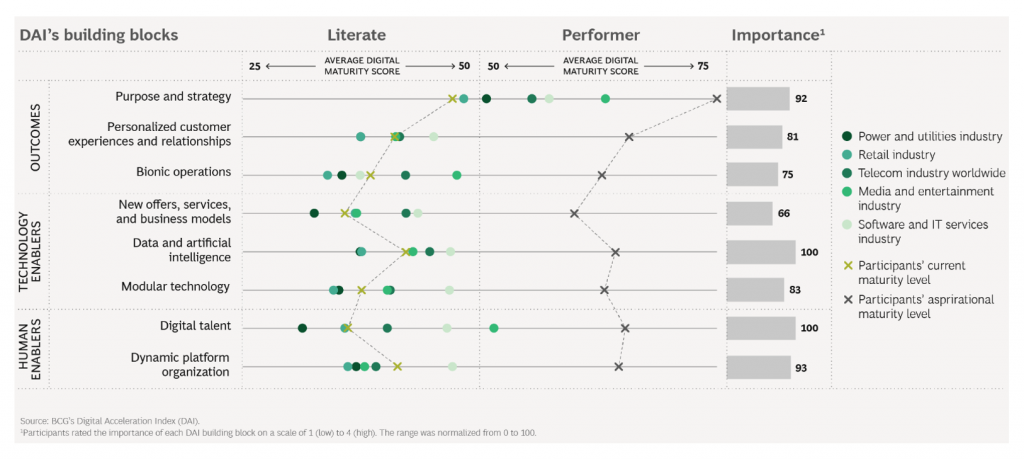Login to access
Want to subscribe?
This article is part of: Executive Briefing Service
To find out more about how to join or access this report please contact us
Change agents know that stakeholders need a picture of the future – or “vision” – to point the way for a transformation. Yet visions can do more to unite and inspire action. How can telcos improve them?
Developing a vision
STL Partners began this investigation with the hypothesis that a vision (some statement of a desired future end state) is imperative to secure stakeholder buy-in for a successful business transformation. As we researched this hypothesis, it became clear that having a vision statement is not enough. Increasingly, transforming telcos do have a vision-like statement of some kind, but they continue to struggle with buy-in and the movement towards new ways of doing things.
A 2021 ETIS study (TeBIT 2021) leveraged BCG’s Digital Acceleration Index (DAI) to evaluate the digital maturity (i.e. extent of transformation) of European telco participants. While typically lagged telco digital maturity levels worldwide, both telcos at a worldwide and European level were rated generally more progressed in terms of their digital purpose, vision and ambition than in any other DAI category (see top line “Purpose and strategy” in figure below): Telcos are putting transformation visions in place. However this does not translate into higher maturity elsewhere (i.e. Technology Enablers or Human Enablers).
Enter your details below to request an extract of the report
Telcos are putting transformation visions in place

Source: ETIS/BCG TeBIT Benchmarking Report 2021
Further to this, in a survey of 56 telco employees (between March and July 2022), STL Partners found that executive visions could do more to drive transformations (figure below). The sample was limited to telcos from the APAC region, however this message has been echoed across STL Partners’ client interactions.
The quality of an executive vision facilitates transformation

Source: Survey conducted by STL Partners, n = 56
This begged the question: if telcos potentially have some kind of “vision” in place, why are these visions not driving transformation?
In this report we examine their vision practices to understand how these may be impacting transformation buy-in and action among stakeholders (particularly those most impacted by the change – employees), as determined by progress of transformation to date. We want to identify how telcos can leverage a vision to guide and unite stakeholders to drive the transformation forward.
What is a vision?
For the purposes of this report, a vision is regarded as a picture of a future that outlines where the company is headed in achieving its goals.
Vision can be provided through a transforming entity’s statements of “purpose”, “ambition”, “mission” or indeed “vision”. Nomenclature varies by organisation, and some may describe their desired future through a combination of the above. We believe that what is important in driving transformation is not the designated labels, but the fact that a picture of the future exists, and that the telco is driving towards it.
One of the biggest proponents of vision as essential for driving change is Dr John P. Kotter, who originally published his seminal work “Leading Change” in 1996. He defines a vision as “a picture of the future with some explicit or implicit commentary on why people should strive to create that future”.
Why does a vision matter?
Organisations need a vision to act as a guiding light or beacon for stakeholders to unite behind and strive towards to realise the transformation. The existence of a vision helps to demonstrate the gap between the organisation’s current status and where it wants to be, making the need for change evident.
A vision reveals the need for change

Source: STL Partners
Kotter says a good vision serves three important purposes:
- It clarifies the direction of change: An effective vision will eliminate confusion or disagreements on direction or doubts on the necessity for change. Asking a simple question – is this in line with the vision? – can eliminate discussion and speed up decision making.
- It motivates people to take action in the right direction: Change may be painful for people in the short term and not in their best interest. A vision helps to overcome reluctance to change.
- It helps co-ordinate the actions of thousands of different people in a fast and efficient way: The alternative may be endless meetings or detailed directives, which is slower and costlier. A good vision enables people to take action without having to constantly check with their boss.
Table of contents
- Executive Summary
- Five recommendations for the “vision story”
- The scope of transformation and the need for a story
- Comparison of approaches
- Next Steps
- Introduction
- What is a vision?
- Why does a vision matter?
- Spark New Zealand
- The need for change at Spark
- The scope of Spark’s transformation
- How Spark communicated its vision for transformation
- Leaders invested time in communication
- Summary of Spark’s practices and results
- BT Digital, UK
- The need for change at BT Digital
- The scope of BT Digital’s transformation
- How BT Digital communicated its vision for transformation
- Summary of BT Digital’s practices and results
- M1, Singapore
- The need for change at M1
- The scope of M1’s transformation
- How M1 communicated its vision for transformation
- Driving the vision home
- Summary of M1’s practices and results
- Conclusions and recommendations
- What to communicate
- How to communicate
- The role of leaders
- Recommendations
Related Research
Previous STL Partners reports aligned to this topic include:
- Elisa: Telco leadership excellence – and how to do it (March 2020)
- Culture, leadershipand purpose in telcos: Four key actions (February 2020)
- Telco 2030: New purpose, strategyand business models for the Coordination Age (December 2019)
